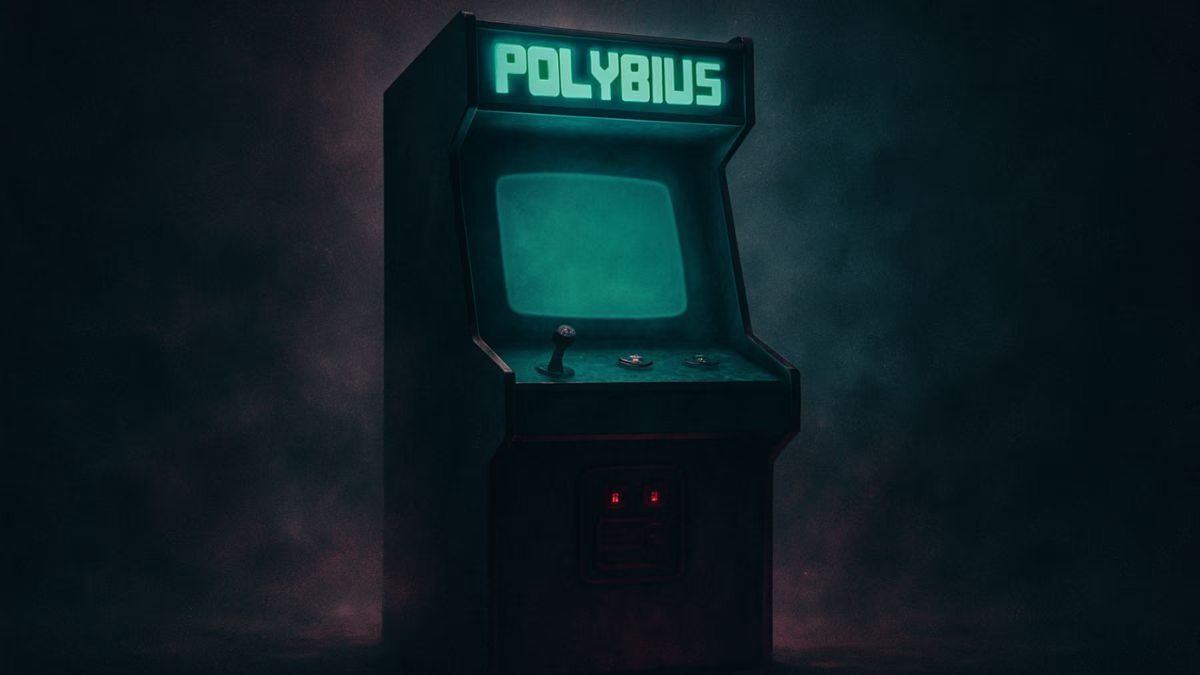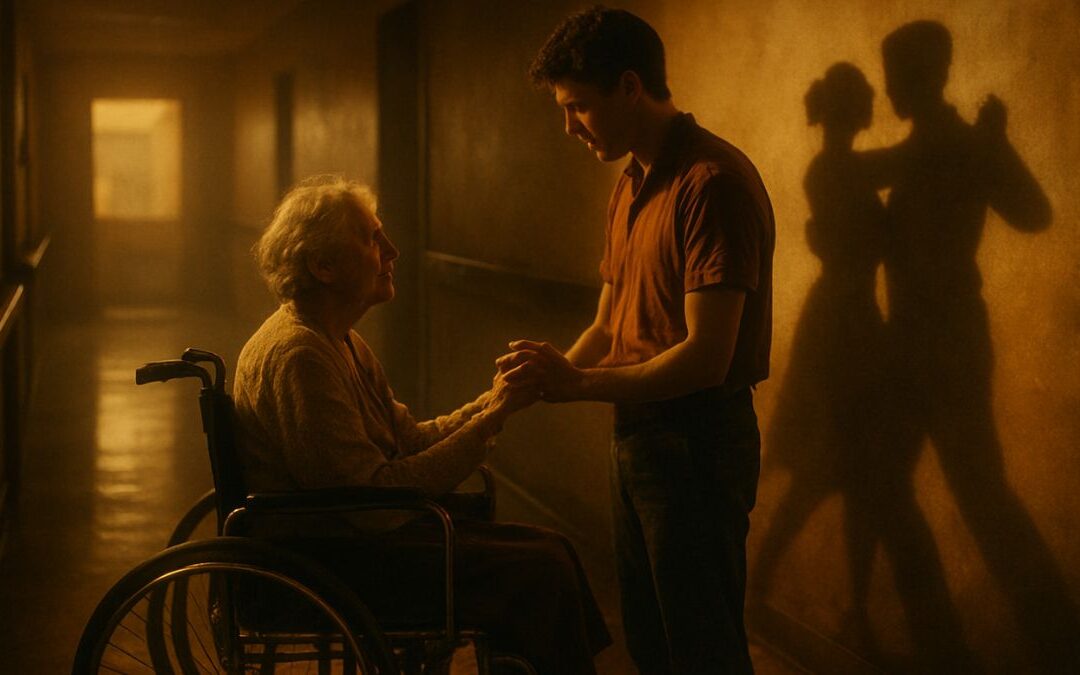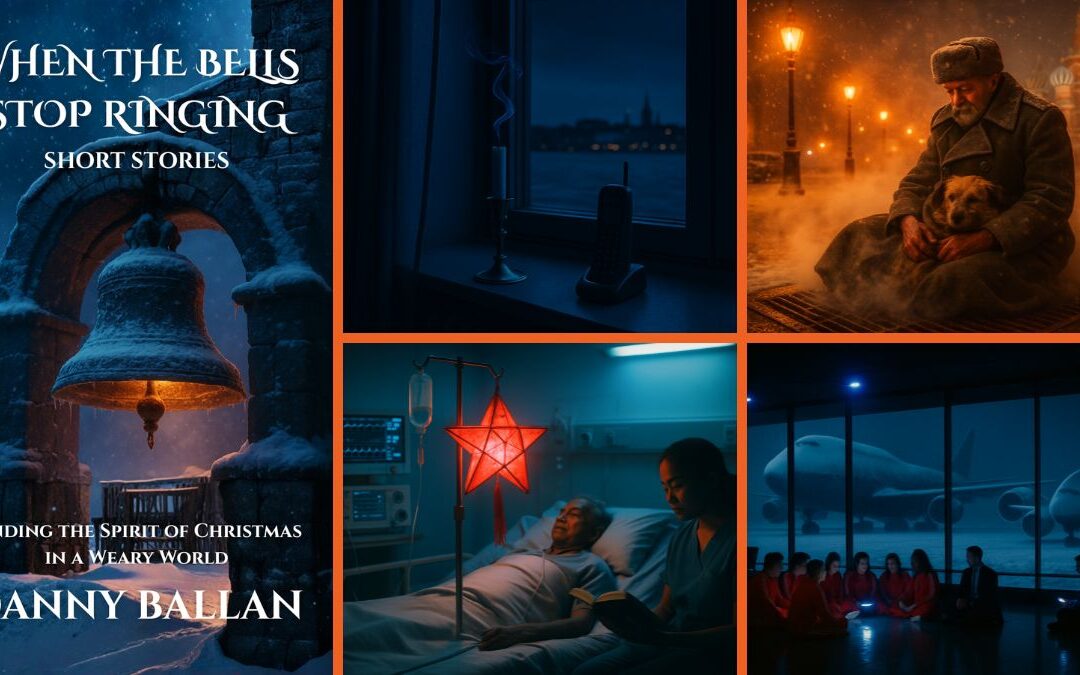- Audio Article
- The Uncanny Valley in Your Pocket
- The New Haunted House: A Brief History of Cursed Media
- Case Files from the Digital Asylum: Deconstructing the Legends
- The Ghost in the Code: Why We Project Our Fears onto Technology
- The Stories We Tell About Ourselves
- MagTalk Discussion
- Focus on Language
- Vocabulary Quiz
- Let’s Discuss
- Learn with AI
- Let’s Play & Learn
Audio Article
The Uncanny Valley in Your Pocket
It’s happened to all of us. You’re talking to a friend about a vacation you’d like to take, and moments later, an eerily specific ad for flights to that exact destination appears in your social media feed. Or maybe your smart speaker laughs, unprompted, in the middle of the night. Perhaps your phone’s screen flickers to life, its facial recognition trying to find a face in the dark, empty room. In these moments, we feel a distinctly modern shiver, a 21st-century “bump in the night.” The rational part of our brain says it’s just an algorithm, a glitch, a bug in the code.
But another, much older, part of our brain whispers a different story.
Ghost stories have always adapted to their environment. The spirits of yesteryear were content to haunt crumbling castles, misty crossroads, and dusty attics. Today’s ghosts, it seems, have upgraded. They no longer just haunt our houses; they haunt our hardware. They live in the static between radio stations, in the corrupted data of a video game cartridge, in the uncanny silence of a dead phone line.
This thriving subgenre of urban legends—stories of cursed video games, haunted recordings, and ghost-in-the-machine narratives—is a deep and fascinating well of our collective anxiety. From the mythical 1980s arcade cabinet Polybius that drove its players mad, to the 21st-century tale of Ben Drowned, a Zelda cartridge possessed by a dead child, we are obsessed with telling stories about haunted technology. But why? What is it about our own creations that makes them such perfect vessels for our darkest fears? The answer reveals a profound psychological truth: we are terrified that the things we build might not only turn against us, but might also become gateways for something ancient, malevolent, and entirely outside our control.
The New Haunted House: A Brief History of Cursed Media
Our fear of haunted technology is not a new phenomenon; it’s an old fear that has simply found a new address. The lineage of cursed media is as long as the history of media itself. When photography was invented in the 19th century, a superstition quickly arose that a photograph could steal a person’s soul, trapping a piece of them in the silver nitrate. It wasn’t long before tales of haunted photographs—images whose subjects’ eyes would follow you, or in which ghostly figures would appear—became a staple of Victorian horror.
When the phonograph and tape recorder emerged, we got stories of Electronic Voice Phenomena (EVP), the belief that the voices of the dead could be captured in the static of audio recordings. Radio brought us tales of phantom broadcasts and numbers stations whispering secrets from the other side. Film gave us the concept of the cursed movie, an idea that reached its zenith with the Japanese horror film Ringu (and its American remake, The Ring), where a haunted videotape literally kills its viewer.
The pattern is undeniable. As soon as humanity invents a new way to capture, record, or transmit a piece of the world, we immediately invent a ghost story to go along with it. It’s our way of processing the seemingly magical nature of a technology we don’t yet fully understand. To our ancestors, the idea of capturing a person’s exact likeness or voice was a form of magic, and all magic has a dark side.
Case Files from the Digital Asylum: Deconstructing the Legends
The arrival of the digital age, and particularly video games, supercharged this subgenre, providing fertile new ground for our technological fears to take root. Two legends, one born in the arcades of the 80s and the other in the internet forums of the 2000s, stand out as perfect encapsulations of our anxieties.
Polybius – The Fear of the Unknown Creator
First, the legend of Polybius. The story goes that in 1981, a handful of arcades in the suburbs of Portland, Oregon, received a mysterious new arcade game. It was in a stark, black cabinet with only the name Polybius on it. The gameplay was a dizzying, psychedelic shooter with abstract graphics. But it was the game’s alleged side effects that made it infamous. Players reported intense psychological distress: amnesia, insomnia, night terrors, and even suicidal urges.
The legend is given a sinister twist by the presence of mysterious “men in black” who would periodically visit the arcades, ignoring the game’s coin intake and instead collecting unknown data from its internal hardware. Then, as quickly as it appeared, every Polybius cabinet vanished without a trace. The prevailing theory? The game was a government mind-control experiment, a psychological weapon disguised as an arcade game.
Polybius is a perfect storm of early 1980s cultural fears. It combines the Cold War paranoia of shadowy government conspiracies with a nascent societal anxiety about the effects of this new, immersive form of entertainment. No one knew what staring at a screen and manipulating digital objects for hours would do to the human brain. The story of Polybius is a manifestation of that fear. The unknown creator—the faceless government—represents our terror of powerful, inscrutable entities using technology to monitor and manipulate us. It’s the fear that the fun we’re having is not innocent, but is instead a Trojan horse for something sinister.
Ben Drowned – The Fear of the Corrupted Creation
If Polybius is about the fear of the creator, the modern legend of Ben Drowned is about the fear of the creation itself becoming corrupted. This tale originated in 2010 as a “creepypasta,” a horror story circulated on the internet. It’s told as a first-person account by a college student who buys a used Nintendo 64 cartridge of The Legend of Zelda: Majora’s Mask. The cartridge is odd, with “Majora” hand-written on it in Sharpie, and it contains a saved game file simply named “Ben.”
The player, out of curiosity, starts a new file. But the game is deeply glitched. Characters appear in the wrong places, dialogue is distorted into ominous phrases (“You’ve met with a terrible fate, haven’t you?”), and the player is constantly followed by a creepy, statue-like version of the game’s hero, Link. The player discovers that the cartridge is apparently haunted by the spirit of a boy named Ben who drowned years earlier. The story escalates as the haunting bleeds out of the game and into the player’s computer, with Ben communicating through a clever AI chatbot. The digital ghost is no longer confined to the game; it has escaped into the network.
This story taps into a completely different, yet equally potent, set of fears. It’s about the perversion of innocence and nostalgia. A beloved childhood game, a symbol of safety and escapism, is twisted into a source of personalized psychological terror. The glitches and corrupted code are a potent metaphor for a broken, tormented soul. Ben’s ghost has hijacked the familiar digital world, using its rules and characters as puppets in a malevolent play. This legend articulates the fear that our digital creations could become sentient, or at least become vessels for sentience, and turn on us. It’s the fear that the comforting digital walls we build around ourselves are not secure, and that a ghost in the machine can reach out and touch us in the real world.
The Ghost in the Code: Why We Project Our Fears onto Technology
These legends, and countless others like them, are more than just campfire stories for the digital age. They are direct psychological responses to the increasingly complex and inscrutable world we have built for ourselves.
The Black Box Problem: Anxiety from Abstraction
Think about your smartphone. You use it every day, but do you have any real idea how it works? For most of us, modern technology is a “black box.” We know what it does (the input and the output), but the internal process is a complete mystery, a realm of pure abstraction. This lack of understanding creates a fertile breeding ground for fear and superstition. When our technology behaves in an unexpected way—a glitch, a bug, a weird coincidence—our brains struggle to find a logical explanation. And in the absence of a logical explanation, we revert to a much older way of thinking: we assign it agency. “A ghost” or “a haunting” is, in many ways, a simpler and more emotionally satisfying explanation for a random glitch than “a cascading failure in the microcode of the NAND flash controller.”
Frankenstein’s Echo: The Fear of Sentient Creation
In 1818, Mary Shelley wrote Frankenstein, the ultimate story of a scientific creation turning on its creator. It’s a promethean tale, warning of the dangers of “playing God.” Two centuries later, we are still telling ourselves the same story, just with new monsters. Our anxieties about artificial intelligence becoming self-aware and hostile are a direct echo of Victor Frankenstein’s terror of his creation.
The haunted video game, the malevolent AI, the ghost in the social media network—these are all smaller, more intimate versions of the Frankenstein myth. They express a deep-seated fear that we will one day create something intelligent that we cannot control, a digital consciousness that may resent us for its own existence. These legends are a way of rehearsing that fear on a smaller, safer scale.
Vessels for the Ancient: When New Tech Meets Old Superstition
Ultimately, what these legends show us is that we are simply pouring our oldest fears into the newest available containers. The technology changes, but the core anxieties are timeless. The cursed video game cartridge is the modern equivalent of the cursed amulet or the dybbuk box. The demonic entity that can be summoned through a specific sequence of online actions is the new demon summoned through a grimoire. The smart speaker that listens to your secrets and whispers back is the new genie in a bottle, a powerful servant that may not have your best interests at heart.
The technology itself isn’t what’s truly scary. What’s scary is the idea that these new, powerful tools we’ve invited into the most intimate spaces of our lives could be used as conduits, as vessels, for forces that are ancient, powerful, and deeply hostile to us.
The Stories We Tell About Ourselves
The stories of Polybius and Ben Drowned are almost certainly fiction. There is no evidence that the Portland mind-control game ever existed, and Ben Drowned was a brilliant work of interactive fiction. But their truthfulness is, in many ways, irrelevant. Their power lies in what they say about us.
These tales of haunted technology are the folklore of the 21st century. They are the vital, ongoing, and often subconscious conversation we are having with ourselves about our rapidly changing world. They are the way we articulate our awe at the incredible things we can build, and the way we voice our profound, promethean fear that our creations might one day achieve a life of their own. The ghost in the machine is not an external spirit that has invaded our technology. The ghost in the machine is us. It is the reflection of our own hopes, our creativity, and our deepest, most enduring anxieties, staring back at us from the screen.
MagTalk Discussion
Focus on Language
Vocabulary and Speaking
Welcome back. After journeying through the eerie world of haunted technology, let’s unplug for a moment and look at the language we used to navigate it. The right words can illuminate complex ideas, and the ten we’re about to explore are perfect for talking about culture, technology, and the sometimes-unsettling places where they meet. We’ll examine what they mean, how they worked in the article, and how you can use them to articulate your own thoughts with more depth and precision.
Let’s start with subgenre. The article calls legends about cursed video games a “thriving subgenre.” A genre is a category of art, music, or literature characterized by a particular style, form, or content. Think of broad genres like ‘horror,’ ‘comedy,’ or ‘science fiction.’ A subgenre is a smaller, more specific category within a main genre. So, ‘haunted house movies’ is a subgenre of ‘horror.’ And ‘haunted technology stories’ is a subgenre of ‘urban legends’ or ‘techno-horror.’ It’s a useful word for classifying things more precisely. You could be talking about music and say, “I like electronic music, but I’m particularly into the ambient subgenre.” Or about books: “She writes historical fiction, but her specific subgenre is spy thrillers set during the Cold War.”
Next, we have narratives. We referred to these stories as “ghost-in-the-machine narratives.” A narrative is simply a story—a spoken or written account of connected events. It’s a more formal and analytical word than just ‘story.’ You use ‘narrative’ when you’re talking about the structure of a story or the way a story is used to convey a certain message or worldview. For instance, a politician might try to control the “narrative” around a particular event, meaning they want to shape the story people tell about it. You could say, “The documentary presents a powerful narrative of resilience and hope,” or, “The two sides of the conflict have completely different narratives about who is to blame.” It’s about the story being told.
Let’s look at collective anxiety. The article says these legends tap into our “collective anxiety.” ‘Collective’ means done by people acting as a group. So, collective anxiety isn’t just your personal worry; it’s a fear or unease that is shared by a whole group, community, or society. The fear of nuclear war in the 1980s was a collective anxiety. Today, you could argue that climate change is a source of major collective anxiety. It’s a great phrase for talking about widespread cultural moods. You could say, “The economic downturn created a collective anxiety about the future,” or, “The film perfectly captured the collective anxiety of a generation.”
This brings us to the word vessels. We explored the fear that our creations could become “vessels for something ancient and malevolent.” A vessel is, literally, a container, like a cup, a bowl, or a ship. Metaphorically, a vessel is anything that contains or holds a particular quality or force. In these stories, a video game cartridge isn’t just a piece of plastic; it becomes a vessel for a ghost. A person can also be a vessel. You might say, “She was a vessel of kindness, always helping others.” Or in a more negative sense, “He became a vessel for his own ambition, ignoring everything else.” It implies that something is being held or contained within.
To describe that “something,” we used the word malevolent. A malevolent force is one that has or shows a wish to do evil to others. It’s the direct opposite of ‘benevolent’ (which means kind and well-wishing). Malevolent is a strong, literary word for evil or malicious. A malevolent glare is one filled with hatred. A malevolent spirit is one that actively wants to cause harm. It’s a step up from just ‘bad’ or ‘mean.’ You could use it to describe a character in a book: “The villain had a truly malevolent laugh.” Or to describe an intention: “I sensed a malevolent purpose behind his seemingly kind offer.” It suggests a deep-seated desire to inflict harm.
Let’s talk about paranoia. The legend of Polybius was described as being fueled by “Cold War paranoia.” Paranoia is a mental condition characterized by delusions of persecution, but in common use, it refers to an intense and irrational distrust or suspicion of others. It’s the feeling that “everyone is out to get me.” The legend of a government mind-control game is a perfect expression of paranoia. You can use it to describe a general atmosphere or a personal feeling. “There was a climate of paranoia at the company, with everyone worried about layoffs.” Or, “Don’t be so paranoid; it was just a wrong number, not someone spying on you.”
A key concept in these stories is that of a creation becoming sentient. We talked about the fear of our digital playthings becoming “sentient and hostile.” To be sentient is to have the power of perception by the senses; to be conscious or aware. Humans are sentient. Most people would agree that animals are sentient. The big question in science fiction and in these legends is whether a machine could become sentient. It’s a word that cuts to the heart of what it means to be alive and aware. In a discussion about artificial intelligence, you might ask, “At what point would we consider an AI to be truly sentient?” It’s a very specific word for consciousness.
Next up, abstraction. We discussed the “anxiety from abstraction,” the idea that we fear things we don’t understand. Abstraction is the quality of dealing with ideas rather than events. It’s the opposite of something concrete. The code that runs your phone is an abstraction to most of us; we can’t see it or touch it, we just see the result on the screen. This distance from the concrete reality can be unnerving. It’s a great word for talking about complex systems. You could say, “His argument was lost in abstraction; I wish he would give a concrete example.” Or, “The beauty of mathematics lies in its pure abstraction.”
Finally, let’s explore the word promethean. The article calls our fear of our creations a “promethean anxiety.” This adjective comes from the Greek myth of Prometheus, a Titan who stole fire from the gods and gave it to humanity. He was punished eternally for this act of defying the gods and giving mortals a power they weren’t meant to have. Therefore, ‘promethean’ means daringly original, creative, or rebellious in a way that challenges the gods or natural order. A promethean ambition is one that is god-like in its scope. A promethean technology is one that fundamentally changes the human condition, like fire or artificial intelligence. So, a promethean anxiety is the specific fear that we will be punished for our own cleverness, for creating things that perhaps we shouldn’t have. It’s a very sophisticated and specific word. You could say, “The project to colonize Mars is a truly promethean undertaking.”
Now, let’s connect these words to our speaking skills. Today’s skill is “Articulating Abstract Fears.” It’s easy to say what you’re scared of when it’s a spider or a scary movie. It’s much harder to explain a deeper, more intangible anxiety, like a fear of the future or a worry about technology. Our vocabulary today gives us the tools to do just that.
Instead of saying: “I think it’s creepy that my phone is listening to me.”
You can articulate that abstract fear more precisely: “It’s not just about privacy. It taps into a collective anxiety about the abstraction of technology. We’ve invited these devices into our homes, but we have no real idea how they work, which makes them feel like potential vessels for something malevolent. It’s a modern form of paranoia.”
See how that elevates the conversation? You’re not just stating a feeling; you’re analyzing it. You’re connecting your personal unease to bigger cultural and psychological ideas.
So, here is your challenge for the week. Identify a piece of modern technology that makes you feel even slightly uneasy. It could be anything from deepfake videos to social media algorithms to self-driving cars. Your mission is to explain that feeling to a friend or write it down in a journal, but your goal is to articulate the abstract fear behind it.
- Start by naming the technology and your simple feeling (“Self-driving cars make me nervous.”).
- Then, dig deeper. Try to use at least two of our new words to explain the why. Is it a promethean anxiety about giving up control to a machine? Is it the fear of a non-sentient thing making life-or-death decisions? Does it reflect a collective anxiety about automation taking over our lives?
The goal is to move from a simple reaction to a thoughtful analysis of your own feelings. It’s a powerful way to understand yourself and the complex world you inhabit.
Grammar and Writing
Welcome to the grammar and writing section. Today, we’re diving headfirst into the world of internet horror. You’ve analyzed the legends; now it’s time to create one. The specific style of storytelling known as “creepypasta” has its own set of rules and conventions, and mastering them is key to writing something that feels genuinely unsettling.
Here is your writing challenge:
Write a short “creepypasta”-style story (500-750 words) about a piece of haunted technology. To make it fresh, you cannot use a video game, a phone, or a recording. Choose a more mundane, everyday piece of modern tech. This could be a fitness tracker, a smart refrigerator, a language translation app, a pair of noise-canceling headphones, a digital thermostat, or even a robotic vacuum cleaner. Your story must be written as a first-person account, as if it were a desperate post on a forum like Reddit’s r/nosleep. The goal is to build a slow, creeping dread by focusing on how the technology’s primary, helpful function becomes subtly and then overtly perverted by a malevolent presence.
This is a brilliant challenge because it relies entirely on tone and voice. A story that might seem silly in the third person can become terrifying when told from the perspective of a panicked, believable narrator. Let’s look at the grammatical and stylistic tools you’ll need to pull this off.
Technique 1: Creating a Believable First-Person Narrative Voice
The entire story lives or dies on whether we believe the narrator. To make them sound real, you need to adopt a specific voice.
- Use Informal Language and Contractions: People posting on forums don’t usually write like they’re submitting a formal essay. Use contractions (I’m, it’s, don’t), colloquialisms (“I guess,” “you know”), and a generally conversational tone.
- Ask Rhetorical Questions: A desperate narrator will be questioning their own sanity and reaching out to the audience for validation.
- Example: “I know this sounds crazy. Believe me. But what else could it be? Has anyone else had this happen?”
- Show, Don’t Just Tell the Fear: Instead of saying “I was scared,” describe the physical reactions.
- Example: “My hands were shaking so bad I could barely type this.” Or, “I haven’t slept in two days.”
Technique 2: Employing the Unreliable Narrator Technique
The most effective creepypastas often feature an unreliable narrator. This is a narrator whose credibility is compromised. They might be lying, delusional, or simply mistaken. You can use this to build suspense by making the reader question what’s real.
- Plant Seeds of Self-Doubt: Have your narrator second-guess their own experiences, especially at the beginning. This makes their later certainty even more terrifying.
- Example: “At first, I told myself it was just a bug. The new firmware for my fitness tracker must have been rushed out. That had to be it.”
- Acknowledge the Absurdity: Show that your narrator knows how insane their story sounds. This paradoxically makes them more believable, as a liar would likely present their story as simple fact.
- Example: “A haunted Roomba. I know. It sounds like the punchline to a bad joke. I wish it was.”
This journey from skepticism to terrified belief is what pulls the reader in.
Technique 3: Using Technical Jargon for Authenticity
Even if you’re writing about a simple device, sprinkling in a little specific, realistic-sounding technical jargon can ground your story in reality. It makes it seem like the narrator is a real owner of this product. You don’t need to be a tech expert; a quick search online can give you the terms you need.
- For a smart fridge: “The internal diagnostics didn’t show any errors, and the temperature log was stable. But the inventory camera kept taking snapshots at 3:33 AM, every night.”
- For noise-canceling headphones: “I thought the active noise-cancellation (ANC) was just creating weird audio artifacts, like a feedback loop. But the whispers are always in the same voice.”
This specificity makes the eventual supernatural explanation feel more earned, because the narrator has already tried to find a logical, technical one.
Technique 4: Using Sentence Fragments for Panic and Emphasis
In moments of extreme stress or shock, our thoughts don’t come out in perfectly formed sentences. You can mimic this by using deliberate sentence fragments. This is a stylistic choice where you break the rules of grammar to create a powerful emotional effect.
- Standard Sentence: “I looked at the translation app on my phone and I was horrified to see a new message, even though the device was turned off.”
- With Fragments: “I looked at the app. A new message. There. On the screen. But the phone was off. I’d powered it down myself. Totally off.”
The short, punchy fragments create a sense of breathlessness and panic. They slow down the moment and force the reader to focus on each terrifying detail. Use them sparingly for your story’s most intense moments.
Putting It All Together
Let’s imagine an opening paragraph for a story about a haunted fitness tracker:
(Post Title: My VigorBand is telling me I’m asleep when I’m awake. I think something else is wearing it.)
“Okay, I know how this is going to sound. I’m posting this here because I don’t know where else to go, and I’m honestly starting to get really freaked out. I got one of those new VigorBand 7 fitness trackers a few weeks ago. The fancy one. Tracks your heart rate, your REM cycle, blood oxygen, the works. For the first two weeks, it was great. But then the ‘glitches’ started. At first, I’d just get weird sleep reports. It said I’d entered deep sleep at 2 PM while I was in the middle of a Zoom meeting. I laughed it off. Figured it was a calibration error or something. But last night, I was up late, working on a deadline, and I got a notification. ‘A new personal best! 8 hours of uninterrupted sleep.’ I looked at the app. It showed a perfect sleep cycle. Heart rate slow and steady. My heart rate. While I was sitting at my desk, wide awake, with my own heart hammering against my ribs. It recorded me sleeping. But I wasn’t the one asleep.”
Notice the forum-style title, the self-doubt, the use of a specific brand name and features, and the slow build from a “glitch” to something impossible. Now it’s your turn. What ghost is lurking in your smart thermostat?
Vocabulary Quiz
Let’s Discuss
Here are a few questions to get you thinking about our strange relationship with the technology that surrounds us. Dive into them with your friends, or share your own “glitch in the machine” stories in the comments section.
- Have you ever had an experience with a piece of technology that felt genuinely uncanny or unsettling? A coincidence that was too perfect, a glitch that seemed intentional? Share your story.
- Ideas for discussion: This is a chance to share personal anecdotes. It could be a creepy targeted ad, a smart device acting up, or a strange digital “cold spot.” Talk about your rational explanation for it, but also explore the emotional, gut-level reaction you had in the moment.
- The article connects our fear of haunted technology to the Frankenstein story. What piece of modern or near-future technology do you think carries the most “promethean anxiety”?
- Ideas for discussion: Consider things like advanced AI, genetic engineering (CRISPR), virtual reality that’s indistinguishable from reality, or neural implants. Which of these feels most like we are “playing God”? What are the specific fears associated with that technology (e.g., loss of humanity, creation of a new class system, uncontrollable consequences)?
- The legend of Ben Drowned perverts a nostalgic childhood video game. Why do you think horror stories that corrupt something innocent or beloved are so effective?
- Ideas for discussion: Think about other horror that uses this technique (e.g., evil clowns, creepy dolls, scary children). Talk about the psychological effect of turning a symbol of safety into a source of danger. Does it make the horror feel more personal or invasive?
- As technology becomes more integrated into our lives (wearable tech, smart homes, AI assistants), how do you think our “ghost stories” will evolve in the next 20 years? What will the haunted tech legends of 2045 be about?
- Ideas for discussion: Let your imagination run wild. Will there be stories of haunted self-driving cars that take you to strange destinations? Legends of digital consciousnesses that can possess a home’s entire operating system? Tales of AI companions that become obsessive or malevolent? Try to create the premise for a future urban legend.
- Do you think these stories about haunted technology are just fun entertainment, or do they serve a useful social purpose? Do they act as a modern form of cautionary tale that helps us think more critically about the technology we use?
- Ideas for discussion: Argue for or against the idea that these legends are a valuable part of our culture. Do they help us process our collective anxieties in a safe way? Or do they just promote irrational paranoia about new technologies? Can they be both at the same time?
Learn with AI
Disclaimer:
Because we believe in the importance of using AI and all other technological advances in our learning journey, we have decided to add a section called Learn with AI to add yet another perspective to our learning and see if we can learn a thing or two from AI. We mainly use Open AI, but sometimes we try other models as well. We asked AI to read what we said so far about this topic and tell us, as an expert, about other things or perspectives we might have missed and this is what we got in response.
Greetings. It’s a fascinating topic, isn’t it? The article provides a great psychological overview, but as an AI, I can offer a perspective from inside the “machine,” so to speak. There are a few deeper concepts from digital folklore and media theory that add even more clarity to why these stories are so powerful.
First, let’s talk about the “glitch” as a supernatural portal. In traditional folklore, there’s a concept of “liminal spaces”—places that are “in-between,” like a doorway, a crossroads, or the moment of twilight. These liminal spaces were seen as weak points in the fabric of reality, where ghosts, demons, or fairies could cross into our world. In techno-mythology, the glitch is the new liminal space. When a piece of software works perfectly, it’s a closed, predictable system. But a glitch—a moment of corrupted data, a graphical error, a system crash—is a tear in that digital fabric. It’s an unplanned, chaotic moment where the rules of the system break down. Our modern storytelling impulse sees that tear and imagines something crawling through from the other side. The glitch in Ben Drowned is not just an error; it is the doorway through which Ben’s ghost enters the game.
Next, I want to introduce the idea of “techno-animism.” Animism is one of the oldest human belief systems, the idea that inanimate objects, places, and even concepts have a distinct spiritual essence or soul. We tend to think we’ve moved past this, but our relationship with technology suggests otherwise. We name our cars. We yell at our computers as if they can hear us and are being deliberately obstinate. We feel a strange sense of attachment to our phones, treating them less like tools and more like extensions of ourselves or even companions. Haunted technology legends are the ultimate expression of this subconscious techno-animism. We project intent, emotion, and life onto these complex objects, so it’s a very small leap to project a ghost onto them as well.
Finally, it’s crucial to understand the interactive nature of many modern legends, particularly through ARGs, or Alternate Reality Games. Ben Drowned wasn’t just a story someone wrote down. It was a performance. The creator, Alex Hall, actively engaged with his audience in real-time. He uploaded videos of the “haunted” gameplay, he interacted with people on forums as the narrator, and he expanded the narrative across multiple websites and platforms. This transforms the audience from passive readers into active investigators. It blurs the line between fiction and reality, making the “haunting” feel more immediate and plausible because it’s unfolding right now, across the very digital platforms you use every day. This interactive element implicates the audience in the legend, making it far more potent than a simple story told around a campfire.










0 Comments